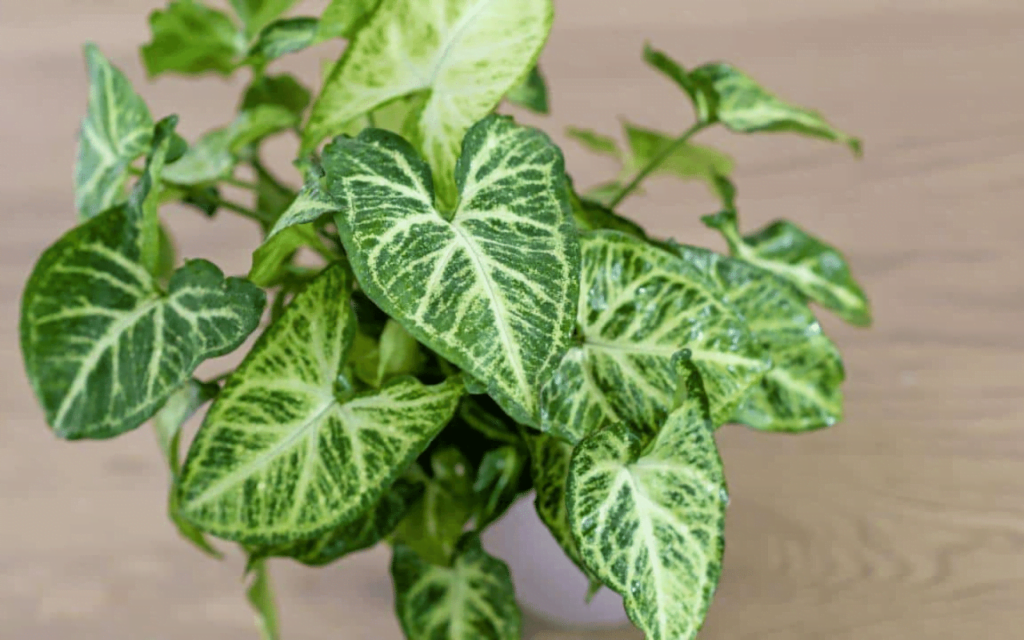Introduction: The Versatile Arrowhead Plant
The Arrowhead Plant, scientifically known as Syngonium, is a quintessential houseplant known for its distinctive arrow-shaped leaves and lush green appeal. Grown in various households globally, it has earned its reputation as a resilient and adaptable plant. This informative delves deep into its care, nuances, and the best practices to help it thrive in an indoor setting.
The Peperomia indoor plant :
| Specification | Details |
|---|---|
| Common Names | Peperomia, Radiator Plant, Baby Rubber Plant |
| Botanical Name | Peperomia spp. |
| Family | Piperaceae |
| Plant Type | Herbaceous perennial |
| Mature Size | Varies by species, typically 6-12 inches tall |
| Sun Exposure | Bright, indirect light |
| Soil Type | Well-draining potting mix |
| Soil pH | Neutral (6.0 to 7.5) |
| Bloom Time | Late summer (though flowering is not its main appeal) |
| Flower Color | Greenish-white (spike-like structures called spadix) |
| Hardiness Zones | Typically grown as houseplants in zones 10-12 |
| Native Area | Tropical regions of South America |
| Benefit | Ornamental, easy-to-care-for, air purifying |
Plant Care
Caring for an Arrowhead Plant is an enjoyable journey, not just a task. Its versatility and adaptability make it a favorite among both novices and seasoned plant enthusiasts. Keeping a few key aspects in mind ensures that your Syngonium flourishes and graces your space with its dynamic presence.
Light
Sunlight is to plants what air is to humans. The Arrowhead Plant thrives in moderate to bright indirect light. While it can tolerate some direct sunlight, prolonged exposure can scorch its delicate leaves. Conversely, inadequate light might stunt its growth and pale its leaves. It’s a balance worth mastering, and the ideal spot for your Arrowhead is near a window with sheer curtains or a location where direct sunlight is filtered.
Soil
The foundation of any plant’s growth, the right soil mix, can make a significant difference in the Arrowhead Plant’s health. This tropical plant prefers a well-draining potting mix, preferably a mix of peat moss, perlite, and pine bark. The soil should be light enough to allow roots to breathe and yet retain sufficient moisture. A pH level of 5.5 to 7 is optimal for the Arrowhead.
Water
Watering, if done judiciously, can ensure your plant remains vibrant. The Arrowhead Plant prefers its soil to be kept slightly moist. Overwatering or letting the plant sit in stagnant water can lead to root rot. It’s crucial to water the plant when the top inch of soil feels dry to touch. During colder months, reduce the watering frequency as the plant’s growth slows down.
Temperature and Humidity
Native to tropical rainforests, the Arrowhead Plant enjoys a warm and humid environment. The optimal temperature range lies between 60°F to 75°F. Avoid sudden temperature drops or cold drafts. As for humidity, a level of 50% or higher is ideal. If the indoor air is too dry, consider placing a humidifier nearby or occasionally misting the plant.
Fertilizer
Like any living organism, the Arrowhead Plant needs its nutrition. Feeding it with a balanced, water-soluble fertilizer every 4-6 weeks during its growing season (spring and summer) supports its vigorous growth. However, during fall and winter, its dormant period, reduce fertilizing to once every 8 weeks or halt it entirely.
Pruning
Pruning is not just about aesthetics; it’s about plant health. Regularly trim off yellow or damaged leaves to allow the Arrowhead Plant to focus its energy on new growth. If you desire a bushier plant, pinch back the new growth tips. Remember, always use sharp, sterilized scissors to avoid infections.
Overwintering
As winter approaches, the Arrowhead Plant’s growth slows down. It’s essential to reduce watering and avoid fertilizing during this period. While the Arrowhead Plant is resilient, ensure it’s kept away from cold drafts, heaters, or fluctuating temperatures.
Propagating Plant
One of the joys of plant ownership is sharing the love. The Arrowhead Plant can be propagated using stem cuttings. Simply snip a healthy stem just below a node and place it in water or moist soil. Within weeks, you’ll witness the growth of new roots, ready to be potted.
Types of Arrowhead Plant
The Arrowhead Plant (Syngonium) isn’t just a one-size-fits-all houseplant. It boasts a variety of species and cultivars, each flaunting unique color palettes and patterns. Some popular varieties include:
- Syngonium podophyllum ‘White Butterfly’: This variety is famous for its creamy-white and green arrow-shaped leaves.
- Syngonium podophyllum ‘Neon Robusta’: A stunning variety with bright pink and green leaves.
- Syngonium podophyllum ‘Pixie’: A dwarf variety perfect for small spaces, it exhibits green and white leaves.
- Syngonium podophyllum ‘Red Heart’: As the name suggests, it has a red tint to its leaves, offering a burst of color.
Common Pests & Plant Diseases with Solution
While the Arrowhead Plant is relatively hardy, it’s not entirely free from pests and diseases. Common issues and their solutions include:
- Spider Mites: Tiny mites that suck plant juices leading to yellowing and droopy leaves. Solution: Wipe down the leaves with soapy water or use neem oil as a preventive measure.
- Aphids: Small bugs that cluster on new growth. Solution: Spray the plant with a mixture of water and a few drops of dish soap.
- Root Rot: Caused due to overwatering or poor drainage. Solution: Repot the plant in fresh, well-draining soil and ensure the pot has drainage holes.
- Leaf Spot: Brown or black spots on the leaves caused by fungal or bacterial infections. Solution: Prune affected areas and ensure the plant is not sitting in excessive moisture.
How to Get the Arrowhead Plant to Bloom
While the Arrowhead Plant’s primary attraction is its foliage, it can bloom under optimal conditions. Here’s how to encourage it:
- Optimal Light: Ensure the plant receives bright, indirect light.
- Consistent Watering: While not liking to be soaked, the plant should never dry out completely.
- Fertilizing: Use a balanced, water-soluble fertilizer during the growing season.
- Age: Mature Arrowhead Plants are more likely to bloom.
Common Problems with the Arrowhead Plant
Like any plant, the Arrowhead isn’t immune to problems. Some common issues include:
- Yellowing Leaves: Often a sign of overwatering. Ensure the top inch of soil dries out before watering again.
- Brown Leaf Tips: Indicates low humidity. Increase humidity by misting or placing a humidifier.
- Leggy Growth: A sign of inadequate light. Move the plant closer to a light source, but ensure it’s indirect.
- Stunted Growth: This might be due to nutrient deficiency. Fertilize the plant as per recommended schedules.
With each variety offering a different aesthetic and challenges unique to the Arrowhead Plant, it’s evident that this houseplant is both a joy and an adventure. Whether you’re troubleshooting problems or simply enjoying its lush growth, the Arrowhead Plant ensures a rich gardening experience.
Signs of a Quickly Declining Plant
While the Arrowhead Plant is robust, neglect or adverse conditions can lead to its decline. Watch out for yellowing leaves (often a sign of overwatering), brown leaf tips (low humidity), or a leggy growth (inadequate light). Addressing these issues promptly can rejuvenate your plant.
Final Thoughts: The Art of Cultivating the Arrowhead
The Arrowhead Plant, with its vibrant foliage and adaptive nature, is more than just a decorative piece. It’s a living entity that, with a little care and attention, can transform any space into a green sanctuary. Embrace the journey of growing this plant, and it promises to be a rewarding experience.
Frequently Asked Questions
Decode the magic of gardens with our guide to Landscaping Styles Frequently Asked Questions.
- Typically, every 2-3 years or when you notice its roots outgrowing the pot.
- Yes, it can be toxic when ingested, especially to cats and dogs. Keep it out of their reach.
- This can be a sign of either overwatering or underwatering. Check the soil moisture to diagnose the issue.
- Yes, like many houseplants, it can help in removing certain toxins and improving indoor air quality.
Recent Posts
- Modern Mural Ideas Transforming Walls into Artworks
- Thematic Table Decor Dressing Your Table for Special Occasions
- Festive Lighting Ideas Brightening Your Home for the Holidays
- Biodegradable Decor Materials Choosing Earth-Friendly Options
- Personalized Space Decor Making Your Home Uniquely Yours
- New Year’s Eve Decor Ringing in the New Year in Style
- Transforming Junk into Decor Upcycling at Its Best
- Second-Life Decor Objects Giving Old Items New Purpose
- Unique Decoration Crafting Standout Ideas for Your Home
- Environmentally Friendly Styling Decor with a Conscience











